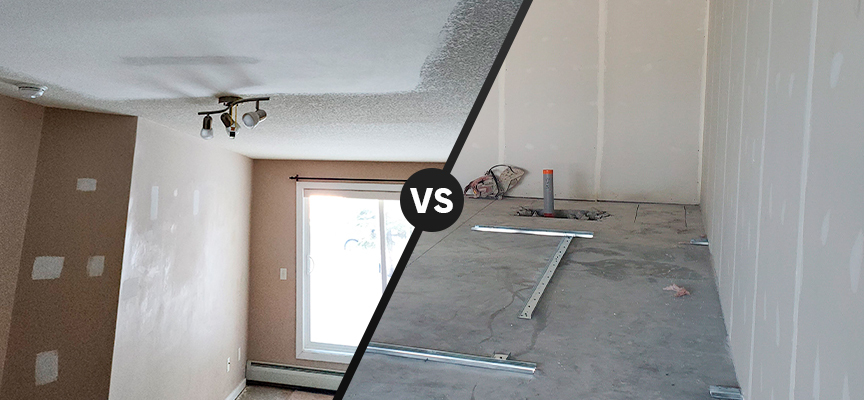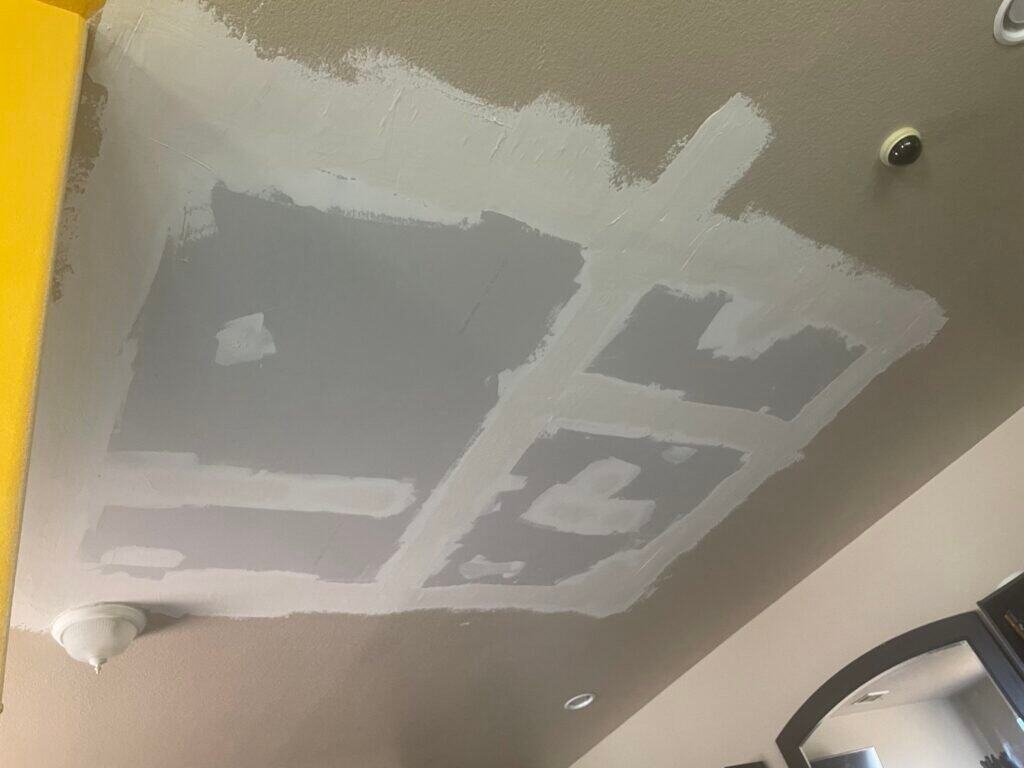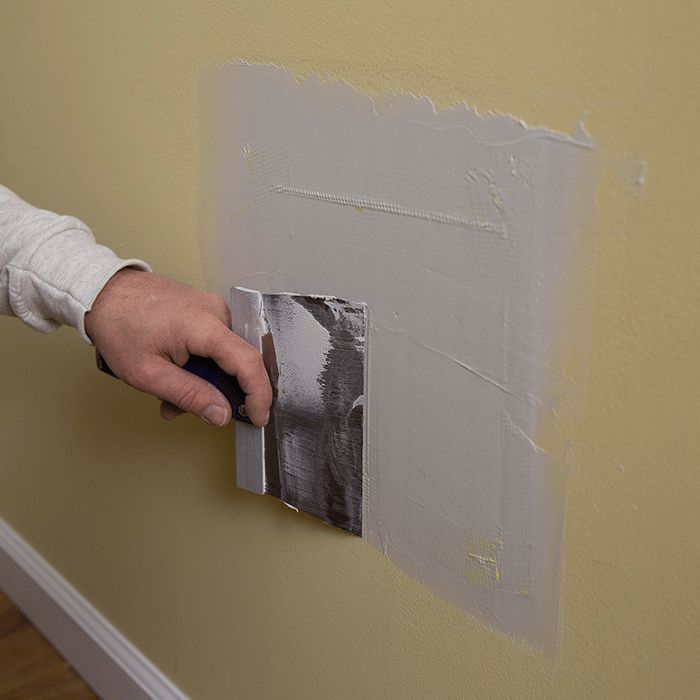Step-by-Step Approaches to Achieving Flawless Drywall Repair Work and Installation
Attaining remarkable drywall repair and setup requires a systematic approach. It includes recognizing the various types of drywall and the tools necessary for the task. Appropriate location prep work is essential before starting any kind of job. drywall contractors. Each action, from patching holes to installing new sheets, needs focus to detail. The procedure doesn't finish with setup; completing methods are vital for a refined appearance. The following steps will ensure a seamless result, however exactly what do they require?
Understanding Drywall Kind and Tools Needed

The installation devices are equally important. An energy blade is vital for cutting drywall sheets, while a drywall saw can assist in making precise cuts for fixtures or outlets. T-squares assure precise measurements, and drywall screws or nails safeguard the panels to wall surface studs. In addition, a drywall lift can assist in the installment of huge sheets, reducing physical stress. Familiarity with these devices and types significantly contributes to the efficiency and top quality of drywall projects.
Preparing the Location for Repair or Setup
Preparing the location for drywall fixing or installation is vital to guarantee a smooth and reliable process. The surrounding space needs to be cleared of furnishings and other obstacles to give ample working room. This not just ensures safety and security yet additionally stops damages to personal belongings. Next off, it is necessary to cover the floor with decrease cloths to catch any debris or dust generated throughout the job.
In addition, the wall surfaces should be inspected for any loosened paint or wallpaper that may conflict with adhesion. Removing these elements produces a tidy surface area for the brand-new drywall. Before beginning, it is suggested to shut off power to electric outlets or fixtures in the vicinity. Making sure appropriate illumination in the work space will further improve exposure and emphasis throughout the repair or installment process. drywall contractor. By carefully preparing the location, one lays the foundation for a successful drywall task
Step-by-Step Process for Patching Holes

Patching openings in drywall calls for a systematic approach to ensure a seamless repair service. The primary step entails reviewing the size of the hole. For tiny openings, a patching substance may be adequate, while larger openings necessitate a spot. Next off, the damaged location needs to be cleaned and prepared by getting rid of any loose debris.
For small openings, applying spackling substance with a putty blade is suggested, smoothing it over the opening and feathering the edges. Once completely dry, sanding the area assures a smooth finish. For larger holes, a drywall spot need to be reduced to size, placed over the opening, and safeguarded with screws. After mounting the patch, the very same spackling process is repeated, complied with by fining sand.
The patched location needs to be keyed and repainted to match the surrounding wall. This careful process ensures an go to this website expert appearance and extends the life-span of the repair work.
Installing New Drywall Sheets: A Comprehensive Overview
Mounting brand-new drywall sheets requires careful planning and implementation to guarantee a sturdy and visually enticing finish. Initially, the area should be determined accurately to establish the variety of sheets required. It is important to pick the ideal density, typically 1/2-inch for indoor walls and 5/8-inch for ceilings or fire-rated applications.
Next off, the studs or structure need to be examined for any type of abnormalities, making certain they are lined up and effectively spaced. When putting the drywall sheets, they need to be positioned flat to reduce seams and boost structural honesty. A drywall lift can be advantageous for overhead installations.
Attaching the sheets with drywall screws at proper periods ensures a protected setup. It is necessary to countersink the screws somewhat listed below the surface area to prepare for the completing process. Complying with these guidelines will bring about a strong foundation, prepared for the next actions in drywall finishing.
Completing Touches: Insulation, Mudding, and Fining Sand Methods
As soon as the drywall sheets are securely secured, the emphasis shifts to the complements that will supply a polished appearance. This procedure begins with taping, making use of either paper or fiberglass harmonize tape to cover the seams between sheets. The tape guarantees a smooth shift, reducing the danger of cracking. Adhering to insulation, mudding is important; a joint substance is used over the tape to fill up gaps and create a seamless surface. Typically, numerous layers are needed, each one feathered out further than the before decrease exposure.
After enough drying time, sanding is the last action in accomplishing a remarkable surface. A fine-grit sandpaper is used to smooth the dried out compound, assuring there are no imperfections or bumps. Focus to detail throughout this phase is significant, as it significantly influences the general appearance of the wall. The end outcome need to be an also, professional-looking surface area prepared for priming and paint.
Regularly Asked Questions
Exactly how Do I Select the Right Drywall Density for My Task?
To choose the ideal drywall thickness, take into consideration the project's function, place, and view website architectural needs. Standard densities consist of 1/2-inch for general usage and 5/8-inch for fire-rated applications, making certain sturdiness and compliance with building regulations.

Can I Set Up Drywall Over Existing Drywall?
Yes, setting up drywall over existing drywall is possible. Nevertheless, it is important to assure the underlying surface area is totally free and safe from damage. Correct fastening and factor to consider of density are necessary for a successful setup.
What Are the Ideal Practices for Drywall Disposal?
The finest practices for drywall disposal consist of recycling when possible, utilizing local waste administration services, and following standards for harmful products if relevant. Interior Painting. Appropriately classifying and securing waste warranties compliance and safety during disposal
How much time Should I Wait On Mud to Dry Prior To Sanding?
Typically, one must wait 24 hours for drywall mud to dry prior to fining sand. Nonetheless, drying time can vary based upon humidity and temperature level, so looking for a firm structure is a good idea before continuing.
Are There Eco-Friendly Drywall Options Available?
Yes, green drywall alternatives are offered. These choices typically utilize recycled products, low-VOC adhesives, and sustainable manufacturing approaches, decreasing environmental impact while offering effective insulation and sturdiness for various construction and restoration tasks.
An utility knife is essential for reducing drywall sheets, while a drywall saw can aid in making exact cuts for outlets or fixtures. Preparing the area for drywall fixing or installment is crucial to assure a smooth and effective procedure. Covering holes in drywall needs a systematic method to assure a smooth repair service. Setting visit this web-site up new drywall sheets needs cautious preparation and execution to guarantee a durable and visually appealing finish. Yes, installing drywall over existing drywall is possible.